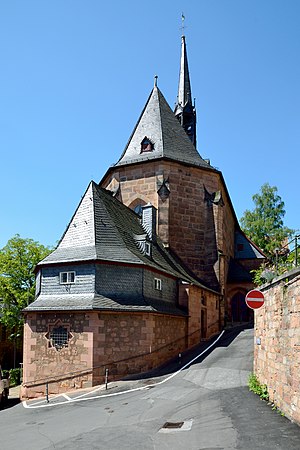St. Johannes Evangelist (Marburg)
| St. Johannes Evangelist (Marburg) | |

|
|
| The spherical church | |
| place | Marburg |
| Denomination | Roman Catholic |
| diocese | Diocese of Fulda |
| Patronage | John the Evangelist |
| Construction year | from 1492/95 to around 1520 |
| Construction type | Hall church |
| function | Parish church - former monastery church |
The Sankt Johannes Evangelist church , also called Kugelkirche , is a Catholic parish church in Marburg . It is located in the upper town and is the youngest medieval religious building in Marburg.
history
The construction of the Kugelkirche began in 1492/95 and was finished around 1520. The building belongs to the former monastery of the Kugelherren, who belonged to the community of Brothers of Common Life . The name of the church ( Kugelkirche ) and the name of the street in which it stands (Kugelgasse) are derived from the headgear of the brothers. They wore a long-pointed hat called a " Gugel ". After the abbey was dissolved in 1527, the church was bequeathed to the newly founded Marburg University. After that it was used temporarily as an auditorium or as a lecture hall by the theological faculty. It has been owned by the Catholic parish since 1827 and is used by them as a parish church. In 1967 a fundamental restoration was carried out, in which the choir room was redesigned in order to adapt it to the changed liturgical needs resulting from the liturgical reform.
architecture
The spherical church is a single-nave building with six bays , five-eighth end and a transept to the west . The two western bays have lower side rooms, as they were changed inside by galleries at the end of the 19th century. The north side of the church has no windows, but the large windows on the south side and the choir create a bright, light-filled room and have tracery windows that are broken up in the late Gothic style .
The rich network vault from 1516 rests on thin services in front of the wall . The net vault between the vault ribs is decorated with Gothic frescoes in the form of radiant wreaths and foliage. The thin services lead in the nave to below the window sills, where they end with a smooth slope. In the choir, on the other hand, they lead down to a plinth, but here too they do not act as a support, but rather as a wall structure. The ribs cross in the capital zone, run in the wall and thus do not sit on consoles or services. After the first third of its total length, the belt arch splits into two arms, each of which strives towards the keystone on the side . The intersecting ribs and the splitting belt arches create a series of intersections that form the network vault. The keystones are adorned with coats of arms and partially stylized or naturalistic tendrils.
Furnishing
A late Gothic painting from 1516 covers the intersections of the vault with floral-ornamental lines. On the north side there is a large tabernacle in the form of a delicately openwork, Gothic spire. A neo-Gothic high altar dates from the end of the 19th century and features a Marian program, the wooden figures of which are partly late Gothic and date to the end of the 15th century. There is also a neo-Gothic Elizabeth altar under the gallery. The font is made up of rich, neo-Gothic shapes.
organ
The organ of the Kugelkirche was built in 1976 by the organ builder Gerald Woehl (Marburg). The purely mechanical instrument has 38 registers on 4 manuals and a pedal . A special feature of this instrument is that the main work does not contain any trumpets, but rather the appropriate registers have been “outsourced” in the IV. Manual “Trompeteria”.
|
|
|
|
|
|||||||||||||||||||||||||||||||||||||||||||||||||||||||||||||||||||||||||||||||||||||||||||||||||||||||||||||||||||||||||||||||||||||||||||||||||||||||||||||||||||||||||||||||||||||||||||||||||||
- Coupling I / II, III / II, IV / II, I / P, II / P, III / P, IV / P
- Playing aids shut-off valves (Hauptwerk, pedal)
Picture gallery
literature
- Joseph Boymann: Marburg as a city of art . Marburg 1924, pp. 38-40
- Georg Dehio: Handbook of the German art monuments. Hessen I, administrative districts of Giessen and Kassel. Munich and Berlin 2008, p. 625
- Rainer Kieselbach and Klaus Laaser (eds.): Marburg . Marburg 2001
- Katrin Petter: Kugelkirche (Catholic parish church) and Kugelkloster (institute building) , in: Marburg. Architecture Guide, ed. by Ellen Kemp
Individual evidence
- ^ History of the parish of St. Johannes Evangelist on www.st-johannes-marburg.de
- ↑ On the disposition of the organ of the Kugelkirche ( Memento from May 27, 2010 in the Internet Archive )
Web links
Coordinates: 50 ° 48 ′ 30.5 ″ N , 8 ° 45 ′ 58.4 ″ E





